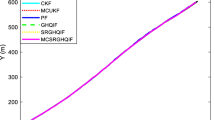Abstract
In this study, the dynamic characteristic of a multi-sensor system made up of such sensors as are sensitive to several parameters is discussed, and the effect of cross-sensitivity on the precision of a measurement system is also discussed. A multi-sensor system is looked as a serial of a linear filter and a memoryless nonlinear system, i.e. Wiener system, and the subsequent information fusion system is regarded as a Hammerstein system, i.e. a serial of a memoryless nonlinear system and a linear filter. On the basis of static calibration, it is presented to determine the inverse filter in a Hammerstein system using blind deconvolution. In order to control the uncertainty of amplitude of signals recovered by blind deconvolution well, a regulation approach to regulating the inverse linear filter coefficient matrixes is presented according to the identity between inverse filter coefficient matrixes and static calibrating matrix. So the approximate inverse dynamic model of multi-sensor system is obtained, the degree of distortion of dynamic measurement result is reduced, the measurement precision is improved, and the need of practice can be reached. Simulation example and simulation result show that the recovered error of the inputs of sensor system, the frequency of which is 1/10 of sampling frequency, is 1/20 of the measurement results without dynamic compensation, and is one half of the measurement results with sole dynamic compensation, and the rapidity is improved 2 times. The dynamic compensation results of a metal oxide semiconductor methane sensor show that the dynamic measurement error is less than one half of that without dynamic compensation. So this method expands the bandwidth of multi-sensor system.
Similar content being viewed by others
References
Huang Junqian, Dynamics of Measurement System (in Chinese), Beijing: Publisher House of Defense Industry, 1996.
Tian Sheping, Application of recurrent network model on dynamic compensation of sensors, Journal of Measuring (in Chinese), 2003, 24(1): 49–51.
Tsung, T. T., Chang, H., Chen, L. C. et al., Analysis of dynamic characteristics of pressure sensors using square pressure wave theory and system identification, Measurement Science and Technology, 2003, 14: 1927–1937.
Zhang, Y., Liu, J. H., Zhang, Y. H. et al., Cross sensitivity reduction of gas sensors using genetic algorithm neural network, Optical Engineering, 2002, 41(3): 615–625.
Legin, A. V., Vlasov, Y. G., Rudniskaya, A. M. et al., Cross-sensitivity of chalcogenide glass sensors in solutions of heavy metal ions, Sensor and Actuators B, 1996, 334: 456–461.
Grys, S., Minkina, W., Fast temperature determination using two thermometers with different dynamical properties, Sensors and Actuators A, 2002, 100: 192–198.
Common, P., Independent component analysis, a new concept?, Signal Process, 1994, 36: 287–314.
Chi, C.Y., Chen, C.H., Cumulant-based inverse filter criteria for mimo blind deconvolution: properties, algorithms, and application to DS/CDMA systems in multipath, IEEE Transactions on Signal Processing, 2001, 49(7): 1282–1299.
Amari, S., Douglas, S.C., Cichoki, A. et al., Novel online adaptive learning algorithms for blind deconvolution using the natural gradient approach, Presented at 11th IFAC Symp. Syst. Ident. Kitakyushu, Japan, July 1997.
Douglas, S.C., Cichocki, A., Amari, S., Multichannel blind separation and deconvolution of sources with arbittrary distributions, Neural Networks Processing [1997], VII, Processing of the 1997 IEEE Workshop, 24–26, Sept. 1997, 436–445.
Cichocki, A., Zhang, L.Q., A daptive multichannel blind deconvolution using state-space model, Higher-Order Statistics, 1999, Proceedings of the IEEE Signal Processing Workshop, June 1999, 14–16.
Amari, S., Chen, T. P., Cichocki, A., Stability analysis of learning algorithm for blind source separation, Neural Networks Letter, 1997, 10(8): 1345–1351.
Park, H., Amari, S. I., Fukumizu, K., Adaptive natural gradient learning algorithms for various stochastic models, Neural Networks, 2000, 13: 755–764.
Cruces-Alvarez, S.A., Cichocki, A., Amari, S., On a new blind signal extraction algorithm: Different criteria and stability analysis, IEEE Signal Processing Letters, 2002, 9(8): 233–236.
Tsoi, A.C., Ma, L.S., Blind deconvolution of dynamical systems using a balanced parameterized state space approach, ICASSP, 2003 IV309–IV312.
Baccarelli, E., Galli, S., A new approach based on “soft statistics” to the nonlinear blind-deconvolution of unknown data channels, IEEE Transactions on Signal Processing, 2001, 49(7): 1481–1491.
Hyvärinen, A., Pajunen, P., Nonlinear independent component analysis: Existence and uniqueness results, Neural Networks, 1999, 12: 429–439.
Carmel, L., Levy, S., Lancet, D. et al., A feature extraction method for chemical sensors in electronic noses, Sensors and Actuators B, 2003, 93: 67–76.
Author information
Authors and Affiliations
Corresponding author
Rights and permissions
About this article
Cite this article
Tang, X., Liu, J. Research on dynamic characteristics of multi-sensor system in the case of cross-sensitivity. Sci. China Ser. E-Technol. Sci. 48, 1–22 (2005). https://doi.org/10.1360/03ye0583
Received:
Revised:
Issue Date:
DOI: https://doi.org/10.1360/03ye0583




